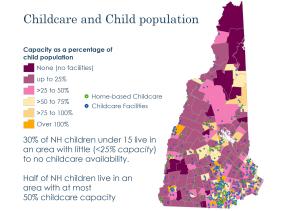Zoning of Home-Based Childcare in NH
A 2024 NH Zoning Atlas Study, in partnership with the Community Development Finance Authority.

New Hampshire is suffering from a shortage of child care, leading to fewer options and higher costs for working parents. Home-based child care can offer a safe and affordable alternative to facility-based childcare, especially for parents in smaller or more rural neighborhoods and communities across the state. However, home-based providers face a number of challenges, including rising housing costs, resistance from landlords, and often complex regulatory and licensing requirements.
To help New Hampshire providers, community leaders, and policy-makers better understand New Hampshire’s need for child-care and the impact of recent 2024 legislation on our communities, as well as what can be done with zoning to facilitate home-based childcare, the NH Zoning Atlas team undertook an analysis that included collecting all of the zoning regulations that govern home-based child care in every community across the state.
Scroll to review our findings or access the data.
Finding #1
New Hampshire has a shortage of childcare. 30% of NH children up to the age of 14 live in an area with little or no childcare.

Finding #2
NH passed a new law, HB1567, to make home-based childcare easier. As of September 24, 2024, communities can no longer prohibit home-based childcare in any home, whether single- or multifamily, and cannot require site plan review or special exception. New Hampshire’s new law will impact four out of five communities.

Finding #3
55% of communities have at least one district requiring special exception and/or site plan review for home-based child care. As of September 24, 2024, the new law HB1567 states that home-based childcare is no longer legally subject to special exception or site plan review.

Finding #4
Even after the new legislation goes into effect, home childcare providers will face regulatory roadblocks in a minority of communities. For example, 36% of communities have restrictions on the size of floor area used for day care or home based businesses in general, 12% of communities still require the provider to obtain a conditional use permit, and 12% of communities ban employees for some types of home-based child day care.

Our Downloadable Assets
To access the data that informed our analysis, click the button below. Please contact us should you have any corrections that we should be made aware of.
Corrections? We froze the zoning data on June 1, 2024, and subsequently collected nearly thousands of pieces of data from over 23,000 pages of NH community zoning codes.
If you see a correction, please help us by emailing us the details at zoningatlas@anselm.edu.
Special thanks to our student intern Molly Mikkonen and research associate Thomas Donovan who conducted the data collection for this analysis.
